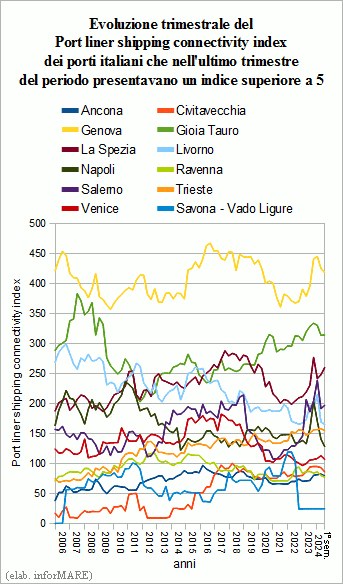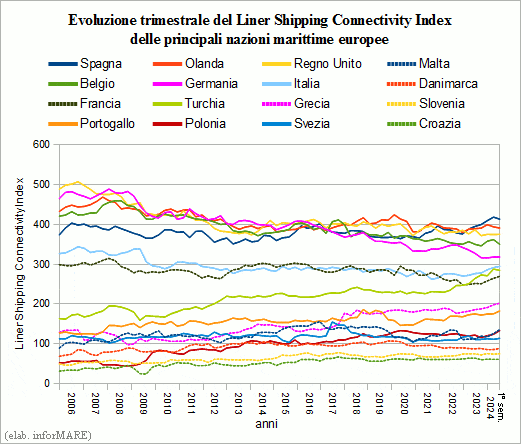
The United Nations Conference on Trade and Development
(UNCTAD) today announced the latest update on the
second quarter of this year, of Liner Shipping Connectivity
Index (LSCI), the index designed by the organization to identify
the degree to which nations are integrated into the global network of
Containerized sea freight services. The index is
was redefined last March and takes into account six
Components: the number of scheduled ship calls per week
in the nation; the annual handling capacity of
containerized cargoes (in TEU containers) of the nation; The number
regular scheduled services to and from the country; The number of
Scheduled shipping companies providing services to and from the
nation; the hold capacity (in TEU) of the vessel plus
great employee in services to and from the nation; the number of others
Countries connected to the nation via ocean freight services
direct lines (which do not require transhipment operations). The
index generation provides that, for each component, the
the data of the country is divided by the average figure of the component
in the first quarter of 2023 and then the average of the
six members of the nation. The average of the components for a given
country and a given quarter is then multiplied by 100. The
result is an average LSCI of 100 in the first quarter of 2019.
2023. All other indices are related to this value (in the
March 2024 The entire dataset has been recalculated on the
based on this reference).
In the second quarter of 2024, the LSCI index for Italy
is 286, unchanged from the same quarter of 2023 and
an increase of three points compared to the first quarter of 2024.
 Today, UNCTAD also released the latest reported update
to the second quarter of this year of Port Liner Shipping
Connectivity Index (PLSCI), the index that identifies the integration of
of a port in the global networks of maritime services
containerized. This index has also been redefined in
2024 with the aim of better reflecting the current characteristics of the
container ports. As of this year, the PLSCI is a
index set at 100 in relation to the average value of the
port connectivity in the first quarter of 2023. The
PLSCI is generated on the basis of six components: the number of
scheduled ship calls per week in the port; Capacity
annual container traffic (in TEU) offered by the port; the
number of regular scheduled sea freight services to and from
the port; the number of liner shipping companies
provide services to and from the port; Capacity (in TEU)
of the largest vessel used in services to and from the
port; the number of other ports connected to the port via services
direct liner shipping (which do not require
transhipment operations).
Today, UNCTAD also released the latest reported update
to the second quarter of this year of Port Liner Shipping
Connectivity Index (PLSCI), the index that identifies the integration of
of a port in the global networks of maritime services
containerized. This index has also been redefined in
2024 with the aim of better reflecting the current characteristics of the
container ports. As of this year, the PLSCI is a
index set at 100 in relation to the average value of the
port connectivity in the first quarter of 2023. The
PLSCI is generated on the basis of six components: the number of
scheduled ship calls per week in the port; Capacity
annual container traffic (in TEU) offered by the port; the
number of regular scheduled sea freight services to and from
the port; the number of liner shipping companies
provide services to and from the port; Capacity (in TEU)
of the largest vessel used in services to and from the
port; the number of other ports connected to the port via services
direct liner shipping (which do not require
transhipment operations).
In first place in the ranking of Italian ports that
have the best connection to the world's network of services
Containerised seafarers still figure Genoa with an index of
418.3, up +5.5% on the second quarter of 2023. At
followed by the port of Gioia Tauro with an index of 314.5 (-4.4%) and
third place went to the port of La Spezia with an index of 260.2 (+12.8%).
This is followed by the ports of Salerno (index 197.0; +5.8%), Livorno (index
165,3; -15.8%), Trieste (index 154.6; +2.6%), Naples (index 128.2;
-18.9%), Venice (index 106.8; +0.9%), Civitavecchia (index 85.9;
-8.9%), Vado Ligure (index 85.9; -26.9%), Ancona (index 79.2;
+10.4%), Ravenna (index 77.1; -11.0%), Taranto (index 31.5;
+9.5%), Marina di Carrara (index 26.5; -21.6%) and Cagliari (index
26,1; -39,4%).
